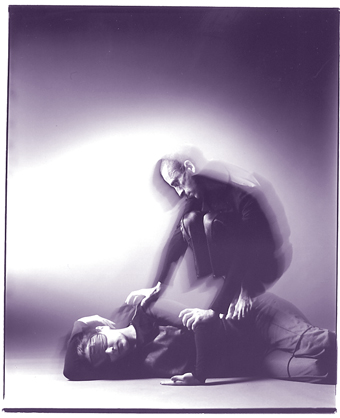Shakespeare’s pillowslips
Philipa Rothfield, Zsuzsanna Soboslay Moore

Trevor Patrick and Rebecca Hilton in Lucy Guerin’s Heavy
photo Ross Bird
Trevor Patrick and Rebecca Hilton in Lucy Guerin’s Heavy
Philipa Rothfield: From the outside
A woman is sitting centre-stage, her back to us. She sidles, slips to her side—prone. She sleeps perchance to dream. Through windows we see 3 sleeping figures line the back of the stage. As a polygraph print-out falls from the ceiling, 3 dancers move from left to right, right to left, their actions as abstract as the graphical representation of sleep. Brainwaves, twitching movements, whole bodies function as a means of dream signification. The abstraction of dance itself is without characters or narrative. Four figures, moving complexities, grouping and regrouping, dissolving into sleep, jerking out of it.
How do we see sleep from the outside in?
BRAIN. Perhaps it is an action of the brain—“delta waves, sleep spindles, REM”, (Heavy program notes). At times the choreography lent itself to such a neuro-physiological explanation. Bodies performed staccato actions, almost surreal, yet doggedly mathematical. The music formed and deformed, oscillating between samples, tracks, voices and evocations. Partners supported weight, shifted mass, turned, and reversed.
MIND. Perhaps the psyche exceeds gray matter—the mind is full of images, thoughts, feelings, and emotions. As Freud illustrated so well, dreams are illogical, disturbing, mysterious experiences, drawing on an unconscious which knows neither order, logic nor the ordered procession of time. The dancers work and rework a little narrative which is (re)played at a variety of speeds: a story which is surreal at any speed. David sleeps, dreams, and wakes up as Ros and Trevor gesture concern, then impishly prance around his body. The men perform a duet, Incubus perching on the sleeping body, summoning dreams.
MOVEMENT. This is a dance, after all. Four bodies in motion, lying in a long diagonal, twitching. They move towards the back corner, in pairs, then a foursome, then a threesome with an odd-woman out. The movements themselves are sweeping, graceful, Zombie-like, sharp, upper body, lower body, and complex combinations, sometimes chiming in with the music, sometimes not. The dancers themselves are stunning, precise to the choreography yet themselves. Rebecca throws herself into a flurry of fast and furious action, David does a confined dance of grace and shifting weight, Trevor rolls his head and body along the back wall, curved spheres translate into 2 dimensions, appreciating each moment of movement, Ros, covering space in a flash, a sprite skipping across the floor, she and Rebecca look out at us: who are they? Are they the dream, the dreamers, the images of a dream, the waves of a brain?
Heavy does not resolve into a final position but our initial sleeper takes her position again, lays herself down to sleep, her back to us, back to front, prone again.
Zsuzsanna Soboslay Moore: From the inside
Those background windowed figures, upright, so we can see. Subjects wired to the dream. The artifice of charting: long polygraph falls, computer spitting out its peaks and dips. This is not how I dream, from outside in. We are the stuffings of sleep, Shakespeare’s pillowslips. Dreams are made of this:
Touch me with silk, I will chant you my palaces. Dip me in quicksilver, I will chart you my night escapades. Knights and dreams and flossy places. I know exactly where I don’t know where I am.
Those thousand and one Arabian nights are tales spun in a heart oscillating with fear. This is the human underface of it. Dreams deal with the puzzles and horrors of life in their sweet/cloying way. Watching Heavy dance, you forget the science of it, the opening night crowd of it; you see patterns (e)merge, patterns of people and patterns of pattern: pairings, shiftings, allegiances that betray you or stay loyal. They are our sanity, these repatternings, as limbs stretch and reclimb the vine and beanstalk that’s been commanded to regrow.
This work, not quite the territory of fairytale, operates in the plane where you might begin to tell a tale. Feel the itch at the edge of a tongue about to speak, story about to be told.
Like spectres, 4 slink in; disappear. Then her breathing back: a thin red peel, silk separating look and blink. She sits like Christine in Hopper’s painting looking across grassy plains; rolls sideways, walking fingers slip us into dream.
Three bodies patterning, one alone. He slips through doors: visits another’s body, climbs in. Against a reflective wall, one smashes sleep; perhaps his Doppelganger breaks free…Twitches, falling faces, touches of Magritte; a Bermuda silliness replayed at double speed and slow-mo.
I remember, a bug-eyed insomniac lurched about by another, playing his wakeful mind; and Rebecca, breaking into jazz, but as if underwater, turning to catch out her shadows. I re-member: Rebecca’s foot-jerks, Trevor’s helpless wrists, David’s pigeon-flying, Ros’ spindly hips. Sometimes, a luna park smile in sinister bones.
And always, the EEG spitting out cocktail limbs.
I remember, it is hard to remember: the territory they dance is largely forming, not formed. A major work which, intriguingly, did not give me dreams, nor make me crave them, but reflected on how they might happen as they are happening. And if nostalgia has a future tense, this might be it.
–
Heavy, a dance inspired by sleep stages one to four, REM, disorders and dreams; choreographer, Lucy Guerin; dancers, Rebecca Hilton, Trevor Patrick, David Tyndall, Ros Warby; sleepers, Nina Rubinstein, Chris White, Kuntamari Crofts; live music mix, Jad McAdam; lighting design, Damien Cooper; costumes, Anna Tregloan; set Christopher Bruce; Athenaeum II, Melbourne, November 7 – 15
RealTime issue #28 Dec-Jan 1998 pg. 37






